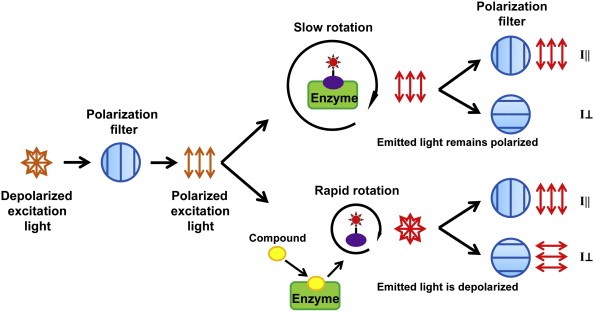Fluorescence Polarization
Fluorescence polarization is a powerful technique used to study the binding and interactions of molecules. It is a type of spectroscopy that measures the orientation of fluorescent molecules as they emit light. Fluorescence polarization can be used to measure a variety of biological processes, including protein-protein interactions, protein-DNA interactions, and enzyme kinetics. Unlike fluorescence intensity, fluorescence polarization specifically analyses as output the emission intensity of different polarization planes.
Fluorescence polarization works by measuring the anisotropy of fluorescent molecules. Anisotropy is a measure of the degree of orientation of a molecule in space. When a molecule is excited by polarized light, it emits light that is also polarized. By measuring the polarization of the emitted light, we can determine the anisotropy of the molecule.
Fluorescence polarization technique is highly sensitive and can detect changes in the orientation of fluorescent molecules down to the level of a single molecule. In addition, fluorescence polarization is a non-destructive technique, and experimental samples will not be damaged and can be used repeatedly. It has a wide range of applications and can be used to study a variety of biomolecules, including proteins, nucleic acids, and small molecules. These advantages make fluorescence polarization an excellent tool for studying various biological processes and detecting small changes in biological systems.
Features that make fluorescence polarization amenable to high-throughput screening:
- Non-radioactive
- Homogeneous
- Ratiometric
- Miniaturizable
 Figure 1. Principle of fluorescence polarization assay (Zeng, H.; Xu, W. 2015)
Figure 1. Principle of fluorescence polarization assay (Zeng, H.; Xu, W. 2015)
Our Services
As an expert in the study of biomolecular interactions, Profacgen provides a powerful fluorescence polarization platform to assist researchers in exploring a variety of biological systems. We have multiple fluorescent dyes to choose from, and offer an upgraded detection system which greatly reduces the incidence of false positive. Based on advanced fluorescence polarization technology, we have developed many services to meet customers' different research needs. With our sensitive, nondestructive and versatile services, we can help you advance and achieve your scientific goals.
Our fluorescence polarization technique can be used to:
- Protein-protein interaction studies: for identifying potential drug targets or investigating mechanisms of disease.
- Protein-DNA interaction studies: for studying transcriptional regulation or identifying potential drug targets.
- Enzyme kinetics study: used to study the mechanism of enzyme action or identify potential drug targets.
- Small molecule binding studies: used to identify potential drug candidates or study the mechanism of drug action.
Profacgen has accumulated lots of experience in fluorescence polarization and biomolecule interaction research. Our professional technical team can provide customers with high-quality fluorescence polarization technique and many related services. Our competitive prices and extensive expertise have earned us the trust of our collaborators. Contact us to find out how Profacgen could be of assistance.
References
- Hendrickson, O.D.; et al. Fluorescence Polarization-Based Bioassays: New Horizons. Sensors. 2020.
- Zeng, H.; Xu, W. Enzymatic Assays of Histone Methyltransferase Enzymes. Epigenetic Technological Applications. 2015.